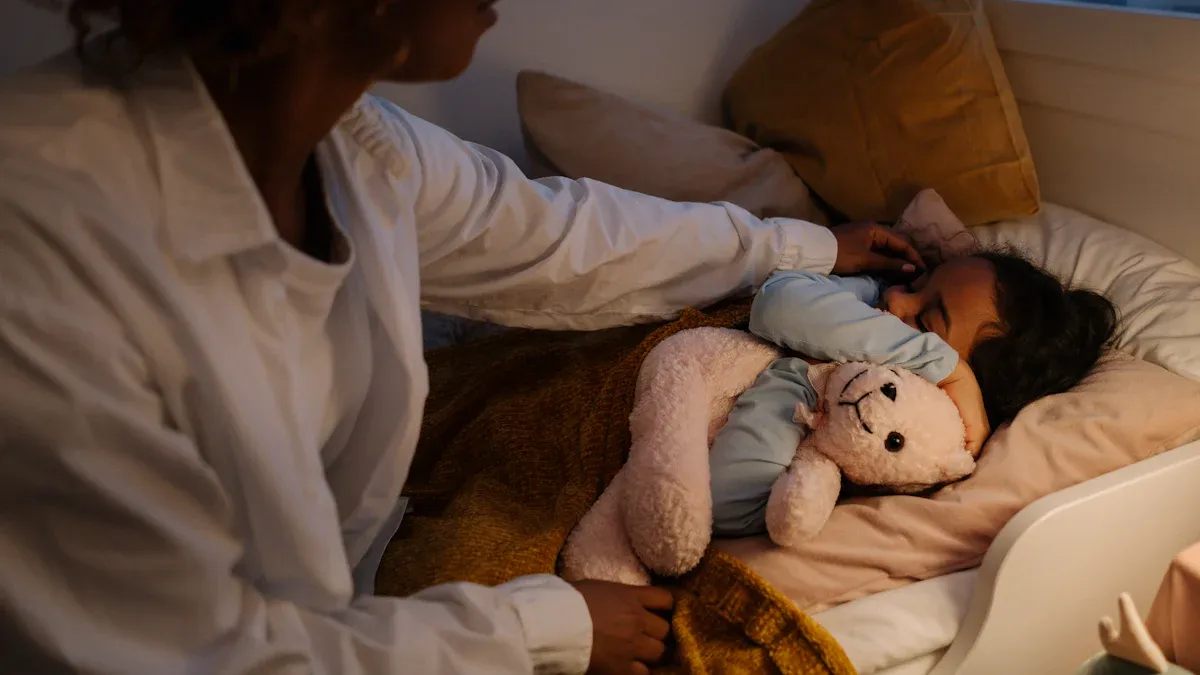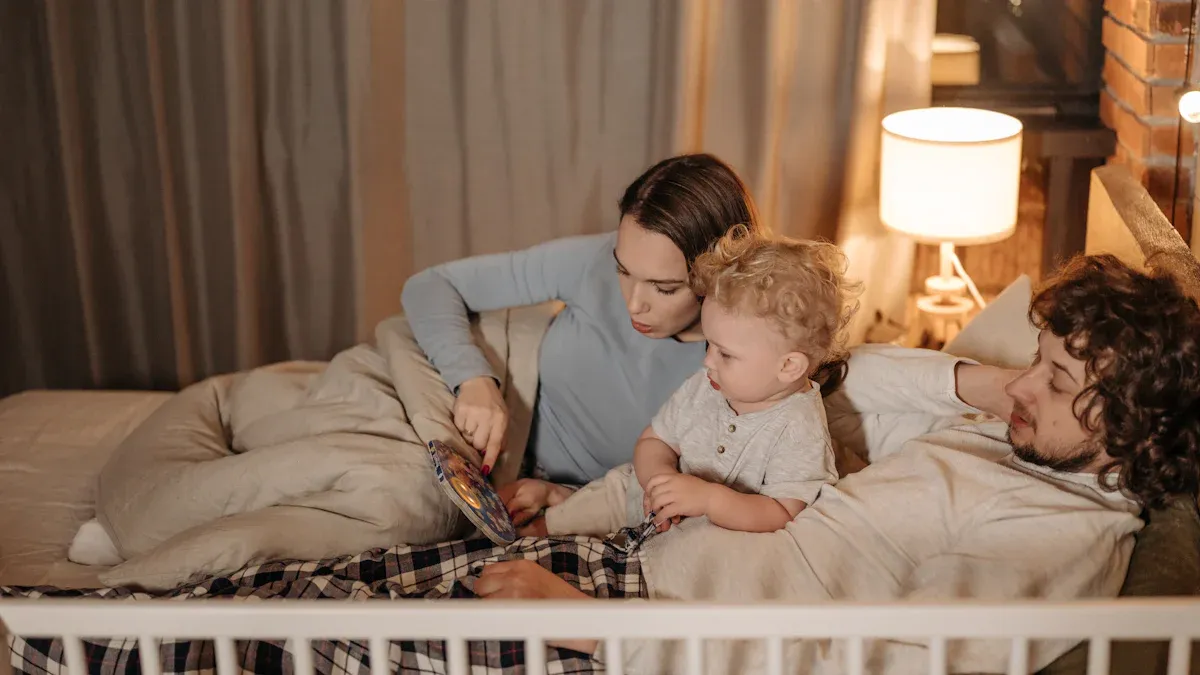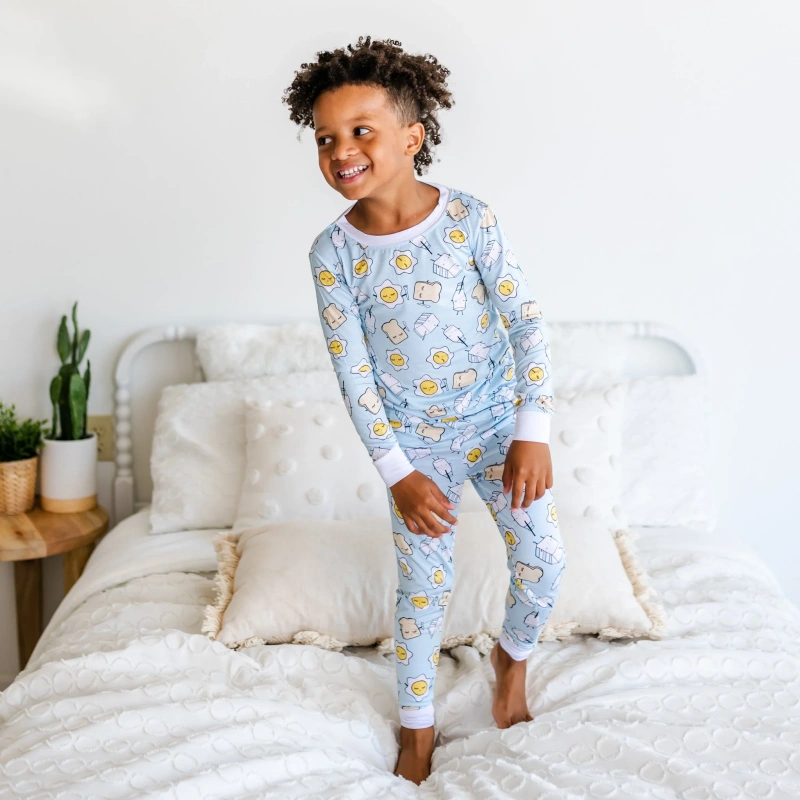
You might find yourself wondering, should i make my son wear pajamas every night? This simple question can feel surprisingly tricky. Every child is unique, and what works for one may not work for another. Comfort, sleep quality, hygiene, safety, and personal preference all play important roles here.
Recent research highlights a few ways pajamas can help your son sleep better:
Trust your instincts—should i make my son wear pajamas depends on what feels right for your family.
Key Takeaways
Choose soft, breathable pajamas made from natural fabrics like cotton or bamboo to keep your child comfortable and help him sleep better.
Using pajamas as part of a consistent bedtime routine signals your child’s brain to relax, improving sleep quality and overall health.
Pick snug-fitting, safe pajamas to help regulate your child’s body temperature and reduce risks like overheating or fabric entanglement.
Listen to your child’s preferences; sometimes clean day clothes or underwear can work if they help your child feel relaxed and sleep well.
Focus on pajamas that are gentle on sensitive skin, free from harsh chemicals, and meet safety standards to protect your child every night.
Should I Make My Son Wear Pajamas?

Comfort and Sleep Quality
When you ask yourself, should i make my son wear pajamas, comfort is probably the first thing that comes to mind. A cozy set of pajamas can help your child relax and signal that it’s time for sleep.
You want your son to feel at ease as he settles in for the night. Pajamas made from soft, breathable fabrics like cotton or bamboo keep the skin cool and comfortable. Loose-fitting pajamas allow your child to move freely while sleeping, so he won’t wake up feeling restricted or tangled.
Here are some tips for choosing pajamas that boost comfort and sleep quality:
Pick natural, breathable fabrics such as cotton, bamboo, or linen for better airflow and temperature control.
Choose loose-fitting pajamas to prevent discomfort or restricted movement during sleep.
If your child sweats at night, look for pajamas with moisture-wicking properties.
Tagless or soft-labeled pajamas help avoid skin irritation, especially if your child has sensitive skin.
Always consider your child’s personal preferences—what feels most relaxing to him will help him sleep better.
When you create a comfortable nighttime routine, you help your son fall asleep faster and stay asleep longer. Pajamas play a big part in making bedtime a positive experience.
Sleep Hygiene
Sleep hygiene means creating healthy habits that make it easier for your child to get good rest. Should i make my son wear pajamas? Pajamas can actually help with this.
When your son changes into pajamas each night, it signals to his brain that it’s time to wind down. This simple step becomes part of a bedtime routine that supports better sleep.
Research shows that children who follow a consistent bedtime routine—like putting on pajamas, brushing teeth, and reading a story—tend to fall asleep earlier and sleep longer. These routines also help with emotional regulation, mood, and even school performance.
Good sleep hygiene keeps your child healthier by preventing illness and supporting skin and oral health. The American Academy of Pediatrics recommends regular bedtime routines because they help children develop strong sleep habits and overall well-being.
So, when you ask, should i make my son wear pajamas, remember that pajamas are more than just clothes—they’re a tool for building healthy sleep habits.
Safety and Temperature
Safety is another important reason to consider pajamas for your child. Children have different needs than adults when it comes to regulating body temperature during sleep. Pajamas help keep your son warm without overheating, especially if you choose the right materials.
Aspect | Evidence Summary |
|---|---|
Thermoregulation and Sleep Quality | Children’s sleep quality depends on staying at a comfortable temperature. Pajamas and bedding help create the right environment. |
Physiological Differences in Children | Kids lose heat faster than adults, so pajamas help them stay warm and safe. |
Bed Microclimate and Clothing | The clothes your child wears to bed affect how warm or cool he feels. Pajamas help maintain a comfortable “microclimate” in bed. |
Implication for Sleepwear | Breathable, snug-fitting pajamas help regulate temperature and reduce risks like entanglement or flammability. |
Infants and young children can’t always control their body temperature. Pajamas made from breathable materials, like Pima Cotton, help keep them comfortable all night.
Snug-fitting pajamas lower the risk of getting tangled in loose fabric and are safer in case of fire.
The right pajamas create a safer sleeping environment, especially for children who can’t adjust their blankets during the night.
If you want peace of mind, look for high-quality pajamas and home wear from trusted brands. Friendtex offers a wide range of options designed for comfort and safety, so you can feel confident about your child’s nighttime routine.
When to Skip Pajamas
Child’s Preference
Sometimes, your child just doesn’t want to wear pajamas. Maybe he feels more comfortable in a favorite T-shirt or even just underwear. That’s okay! Every child has unique preferences, and comfort plays a big role in how well he sleeps.
Some kids, especially those with sensory sensitivities, might find pajamas itchy or tight. You might notice that your son falls asleep faster and wakes up happier when you let him choose what to wear to bed. Listening to your child’s feedback helps you make the best decision for his sleep routine.
Clean Day Clothes
There are nights when your son might want to sleep in his clean day clothes. Maybe he’s had a late night or just feels too tired to change. As long as the clothes are clean and comfortable, this can work for some families.
You don’t have to worry if it happens once in a while. Just make sure the clothes are soft, not too tight, and free from zippers or buttons that could bother him during sleep. This small change can make bedtime easier and less stressful for everyone.
Special Situations
You might face special situations where pajamas aren’t the best choice. For example, children with Autism Spectrum Disorder (ASD) often have unique sensory needs. Some kids respond better to compression garments or specific fabrics.
Age also matters—older children may understand their own comfort better and can help with the decision. Family routines, stress levels, and even travel can affect what works best at bedtime.
If your child has sensory challenges, talk with a therapist or doctor for advice. They can help you find the right sleepwear or routine for your family.
Tip: The most important thing is to keep your child clean and comfortable. Letting your son have a say in his bedtime routine can help him feel more independent and relaxed.
Health and Safety

Fabric Choices
When you pick out pajamas for your son, fabric matters more than you might think. Some materials, like polyester, can shed microplastics during wear and washing. These tiny particles may build up in the body and cause skin problems, especially if your child has sensitive skin.
Many parents find that natural fabrics, such as cotton, bamboo, or lyocell, feel softer and help with temperature control. Studies show that lyocell and cotton both reduce itching and keep skin comfortable, which is great news if your child struggles with dryness or irritation.
You want pajamas that feel gentle and allow your child’s skin to breathe all night.
Friendtex understands how important fabric choice is for your family. Their sleepwear uses high-quality, safe materials that support comfort and well-being.
Skin Sensitivity
If your child has allergies or sensitive skin, you know how tricky bedtime can get. Some kids react to rough seams, tags, or harsh dyes. Choosing pajamas made from hypoallergenic fabrics can make a big difference. Look for tagless designs or flat seams to avoid irritation.
Certified organic fabrics, like those with GOTS or OEKO-TEX labels, give you peace of mind. These certifications mean the pajamas are free from harmful chemicals and safe for even the most delicate skin. Friendtex offers options that meet these high standards, so you can trust what touches your child’s skin.
Tip: Always wash new pajamas before the first wear to remove any leftover dyes or finishes.
Regulations
Safety rules for children’s sleepwear help protect your child every night. In the United States, the Consumer Product Safety Commission (CPSC) sets strict guidelines. Here’s what you need to know:
Pajamas must pass flammability tests or fit snugly to lower fire risks.
Sleepwear for kids above 9 months up to size 14 must meet these standards.
Labels must show correct sizing and warn about any risks.
No drawstrings or small parts that could cause choking.
Third-party labs test sleepwear before it reaches stores.
Recent clinical guidelines also recommend checking for quality stitching and safe dyes. Friendtex follows these rules closely, so you can feel confident about your child’s bedtime routine.
Bedtime Routines
Consistency
You might wonder why sticking to the same bedtime routine matters so much. Research shows that children with a regular routine fall asleep faster, wake up less during the night, and even behave better during the day.
The Penn State INSIGHT study followed children for years and found that those with a consistent bedtime routine had better emotional control and less impulsivity. Another global study with over 10,000 kids found that starting and keeping a bedtime routine from infancy led to longer sleep and fewer night wakings.
When you keep bedtime predictable, you help your child’s body and mind know it’s time to rest.
Tip: Try to keep the same order of activities each night—like pajamas, brushing teeth, and reading a story. This helps your child feel safe and ready for sleep.
Independence
A bedtime routine is not just about sleep—it also builds independence. When you let your child take part in the routine, he learns to manage his own needs. For example, he can pick out his pajamas, brush his teeth, or choose a bedtime story.
These small choices help him feel in control and proud of himself. Over time, your child will start to do more steps on his own, which boosts confidence and self-reliance. You can encourage this by giving gentle reminders and lots of praise.
Family Habits
Family habits shape how bedtime routines work in your home. Many parents follow the same routine they grew up with, sometimes without even thinking about it. A national poll found that 90% of parents have a bedtime routine for their young children.
Common activities include brushing teeth, reading stories, and talking about the day. These shared habits make bedtime feel special and help everyone wind down together.
If you want to improve your routine, try adding a calming activity or turning off screens earlier. Remember, what matters most is finding a routine that fits your family’s needs and helps your child sleep well.
Wear Pyjamas or Pajamas?
Terminology
You might notice people use both “pyjamas” and “pajamas” when talking about sleepwear. The difference comes down to where you live. In the United States, most people say “pajamas.” If you travel to the United Kingdom, Australia, or other parts of the world, you’ll see “pyjamas” instead.
Both words mean the same thing—comfortable clothes you wear to bed. The spelling just reflects local language habits. So, if you ever wonder whether to say “wear pyjamas” or “wear pajamas,” remember that both are correct. You can use whichever feels natural for your family or matches your favorite books.
Fun fact: The word “pyjamas” comes from the Hindi word “pāy-jāma,” which means leg clothing. Over time, the spelling changed as the word traveled around the world.
Choosing What’s Best
When you decide what your child should wear to bed, the spelling matters much less than the sleepwear itself. What really counts is how the pajamas—or pyjamas—help your child sleep. Research shows that the type of fabric you choose can make a big difference in sleep quality. Here’s what studies have found about sleepwear materials:
Wool sleepwear helps children fall asleep faster and wake up less during the night compared to cotton or polyester.
Wool also keeps the body at a comfortable temperature, which means better rest and fewer sleep disruptions.
Even if wool feels a bit rough, it still supports better sleep than other fabrics.
Cotton also performs well, especially for children with sensitive skin.
The right sleepwear can shorten the time it takes to reach deep sleep and reduce how often your child wakes up.
So, when you think about whether your son should wear pyjamas or pajamas, focus on comfort, breathability, and temperature control. The name on the label does not affect how well your child sleeps. What matters most is that your child feels cozy and safe, no matter which word you use.
Tip: Let your child help pick out their sleepwear. When kids feel involved, they’re more likely to enjoy bedtime and sleep soundly.
Conclusion
You want your son to get the best sleep possible. Pajamas can help, but your child’s comfort matters most. Every family has its own routine, so trust your instincts when you make this decision.
Listen to your child and see what helps him sleep well. If you want safe and cozy options, check out Friendtex for quality sleepwear that supports healthy rest.
FAQ
What if my son refuses to wear pajamas?
You can let him choose his own sleepwear. Kids often feel more comfortable when they have a say. Try soft, tagless options. If he still resists, focus on clean, comfortable clothes for bedtime.
How often should I wash my son’s pajamas?
Wash pajamas after 2-3 wears, unless they get dirty or sweaty. Clean sleepwear helps prevent skin irritation and keeps your child feeling fresh at night.
Are pajamas necessary in hot weather?
Lightweight pajamas or even just underwear work well in summer. Choose breathable fabrics like cotton. The goal is to keep your child cool and comfortable.
Can my son sleep in his underwear?
Yes, many kids prefer it. As long as he feels comfortable and stays warm enough, underwear is fine for sleep. Just make sure his bedding is clean and cozy.
What makes Friendtex pajamas a good choice?
Friendtex uses soft, safe fabrics and pays attention to quality. You get comfortable, well-made pajamas that help your child sleep better. Their designs also fit many preferences and needs.


